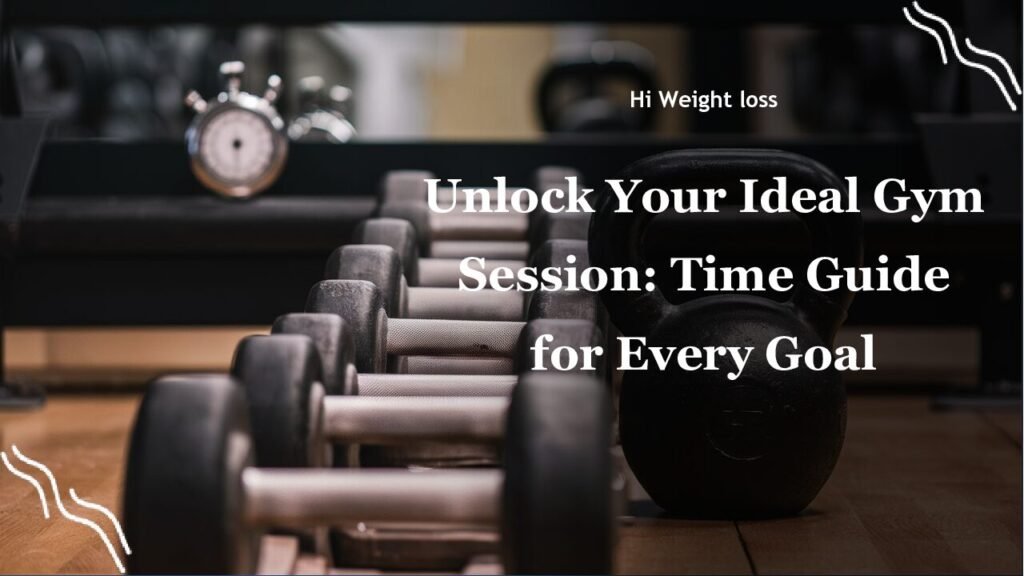“`
Feeling lost in the gym, wondering if you’re spending too much or too little time there? It’s a common question, and the answer isn’t always straightforward. You might see some people sweating it out for hours, while others breeze through in what seems like minutes. So, how long *should* a gym session be? This article will explore the ideal workout durations for different fitness goals, ensuring you maximize your time and effort. We’ll look at the specifics for general fitness, muscle gain, fat loss, and cardio endurance, helping you create a workout plan that fits your needs.
How Long Should a Gym Session Be? Finding Your Perfect Workout Time
General Fitness and Health: The Sweet Spot
If your goal is simply to maintain a good level of fitness and overall health, you don’t need to live at the gym. A good target is around 30 to 60 minutes per session. This range allows you to get in a solid mix of cardio and strength training without overdoing it. I remember when I first started working out, I aimed for an hour but found it was just too much too soon. It was better to start shorter and work up from there, and I discovered that 30-45 minutes was the most beneficial when starting out.
How Long Should a Gym Session Be for Muscle Gain?
When it comes to building muscle, the length of your workout can vary depending on how many times a week you hit the weights. For those who only lift once a week, sessions can be longer, around 60 to 90 minutes. If you’re training two or three times a week, 45 to 60 minutes is usually sufficient. For those dedicated gym-goers who are training four or five times a week, sessions can be shorter, ranging from 20 to 60 minutes. These shorter sessions can still effectively stimulate muscle growth while allowing your body time to recover. It’s all about finding the right balance. A friend of mine once tried doing 2-hour lifting sessions daily, and instead of muscle gain, they experienced extreme fatigue and had to dial it back.
My own experience echoes this: shorter, more focused workouts, combined with adequate rest, have yielded better muscle growth and overall results. When I tried to train daily, fatigue and frustration led to little progress. But reducing training time, while focusing on intensity, saw me progress faster.
Here’s a quick breakdown:
| Training Frequency | Typical Session Length |
|---|---|
| 1 day per week | 60-90 minutes |
| 2-3 days per week | 45-60 minutes |
| 4-5 days per week | 20-60 minutes |

How Long Should a Gym Session Be for Fat Loss?
For those focused on fat loss, the approach is a little different. You’ll want to incorporate a mix of workout styles. High-Intensity Interval Training (HIIT) workouts are super effective and can be done in short bursts, typically 20 to 30 minutes. I’ve seen great results when doing HIIT workouts that last less than 30 minutes, they always leave me feeling like I’ve accomplished a lot. You should also incorporate longer, moderate-intensity workouts like jogging or cycling, aiming for 45 to 60 minutes. These longer sessions are great for burning calories and boosting your metabolism.
Finding the right balance of intensity and duration has been key for me in achieving my own weight loss goals. A friend of mine found that focusing solely on long, slow cardio wasn’t as effective as mixing it with shorter, intense sessions. This strategy can help you effectively burn fat while preserving muscle mass.
How Long Should a Gym Session Be for Cardio Endurance?
If building your cardiovascular endurance is your primary focus, you’ll need to dedicate more time to cardio activities. Aim for longer, sustained sessions ranging from 60 to 90 minutes. Activities such as running, swimming, and cycling are great for building endurance. The key here is to maintain a steady pace for a longer duration. This approach helps improve your cardiovascular system and overall fitness. From my own experience, starting with shorter sessions and gradually increasing the duration allowed me to build endurance over time, and also helped me learn how to properly pace myself.
You can also explore different types of cardio workouts to make it interesting. One thing I’ve personally found helpful is using a heart rate monitor to see if I’m in the right heart rate zone for endurance training, this helps keep me on track while maximizing the benefits of the workout.
Key Factors Affecting Workout Duration
It’s also important to remember that your overall workout time includes more than just the main exercise. Warm-ups, rest periods, and stretching also play an important role and can affect the total time you spend at the gym. Make sure you dedicate enough time to each of these to maximize your results and minimize your chance of injury. General fitness should involve a good mix of strength and cardio, which needs to be factored into your workout time.
As some experts suggest, building strength or endurance can require longer sessions, especially if you’re dedicating a large chunk of time to these goals, but it is important not to overtrain. It’s important to keep in mind that shorter and more frequent workouts can sometimes be more effective than very long ones. According to a Livestrong article, when focusing on weightlifting, a shorter time can be very effective when training multiple times per week.
Conclusion
In summary, how long you should spend at the gym varies significantly based on your goals. For general fitness, aim for 30 to 60 minutes. If your goal is muscle gain, aim for 45 to 90 minutes depending on your training frequency, while fat loss benefits from a mix of short HIIT workouts (20 to 30 minutes) and longer moderate-intensity sessions (45 to 60 minutes). For endurance, plan for 60 to 90 minutes of sustained cardio. Remember to include time for warm-ups, cool-downs, and rest within your workout. My own experience is that consistency and focus are much more important than just trying to spend more time at the gym. It’s about quality, not just quantity, and that is the approach that has yielded the best results for me. So, find what works best for you, and always listen to your body. Feel free to share your own workout routines in the comments below. Are there any specific challenges that you are facing in establishing your ideal gym routine?
FAQ
Is it better to workout for a shorter time more frequently or longer sessions less often?
It depends on your goals and preferences. Shorter, more frequent workouts can be good for consistency and recovery, while longer sessions may be better for endurance or focused strength training. The most important aspect is staying consistent. If you’re struggling to stay consistent, start by building a shorter more frequent schedule.
Can I workout too long at the gym?
Yes, overtraining can lead to injuries, fatigue, and decreased performance. It’s important to listen to your body and ensure that you’re not exceeding the recommended session lengths based on your goals and fitness level.
How can I maximize my gym time?
Focus on quality over quantity. Plan your workouts ahead of time to maximize efficiency, and don’t forget to warm up and cool down. Also, remember that proper form is much more effective than doing as many reps as possible.
What should I do if I can only workout for a short amount of time?
Even a short workout is better than no workout. If time is limited, focus on high-intensity exercises. You can make use of compound movements that work multiple muscle groups in one go. Remember that any kind of physical exercise is beneficial, so making the most of the limited time you have is key.
“`



